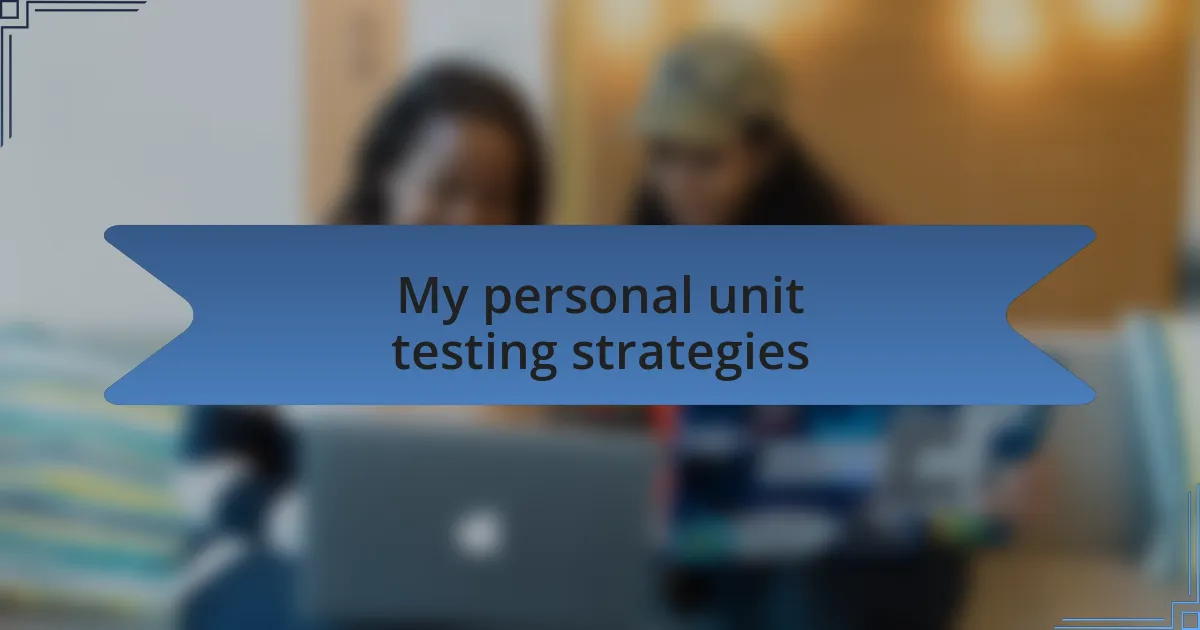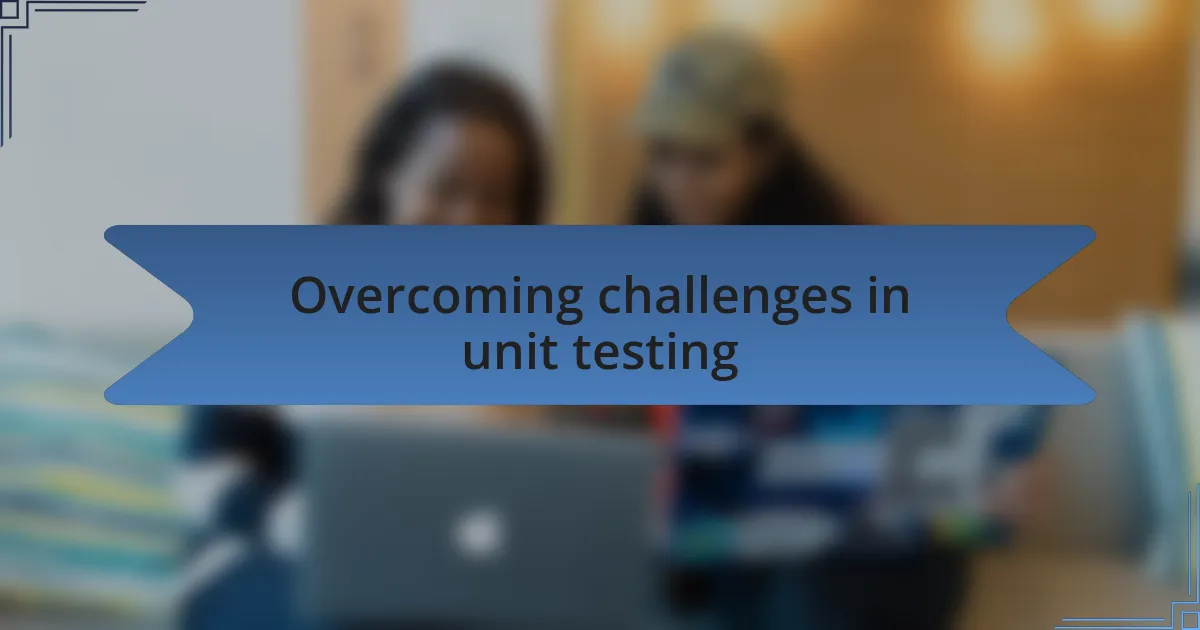Key takeaways:
- Unit testing verifies individual components, improving software stability and developer confidence.
- Core principles include testing small units in isolation, writing clear and descriptive tests, and running tests frequently.
- Adopting strategies like test-driven development and maintaining a test-first mindset enhances code maintainability and debugging efficiency.
- Addressing challenges such as maintaining test coverage, dealing with flaky tests, and overcoming psychological barriers is essential for effective unit testing.

Understanding unit testing practices
Unit testing practices revolve around the idea of verifying individual components of your software to ensure they work as intended. I vividly remember the first time I implemented unit tests in a project; it was like flipping a switch that illuminated areas of my code I hadn’t even realized were flawed. Have you ever found bugs in production that felt utterly baffling? Unit testing can often save you from those frustrating moments by catching issues early in the development process.
As I delved deeper into unit testing, I discovered its profound impact on not just stability but also on my confidence as a developer. Each passing test provided a sense of accomplishment, creating a safety net that encouraged me to refactor with ease. This dynamic not only enhances code quality but also fosters a culture of continuous improvement within development teams. If we consider unit tests from a broader perspective, how can we expect to maintain high software standards without a solid foundation in testing?
I’ve learned that adopting best practices in unit testing—like testing small units of code, using mocks for dependencies, and following naming conventions—can significantly streamline the development process. It’s fascinating how these seemingly small practices can lead to a more maintainable codebase. Have you ever thought about how your testing strategy could shape not just your code, but also your approach to problem-solving? In my experience, refining testing practices can be as rewarding as perfecting the code itself.

Core principles of unit testing
When discussing core principles of unit testing, one fundamental aspect is the focus on testing small units of code in isolation. I remember working on a feature that seemed straightforward, yet after several changes, it started behaving unpredictably. It wasn’t until I dissected the code and tested individual functions that I could pinpoint the sneaky bug hiding within. Doesn’t it feel satisfying when you break down problems into manageable chunks and solve them one by one?
Another essential principle is the importance of writing tests that are clear and descriptive. On a previous project, I adopted the practice of naming my test cases in a way that makes their purpose immediately clear. This not only helped my teammates understand my intentions but also saved time in the long run. Have you ever looked at test results only to be puzzled about what a test failure implies? Well-structured names can provide clarity, and ultimately a shared understanding across the team.
I also believe in the value of running tests frequently. In my experience, integrating tests into the development workflow has transformed my coding routine. Each time I push changes, I feel a surge of reassurance knowing that my tests are running to catch anything that might have slipped through. Isn’t it comforting to have that layer of security? Making testing a habit becomes an integral part of our development culture, laying the groundwork for robust software that stands the test of time.

Common unit testing frameworks
When it comes to common unit testing frameworks, I’ve had extensive experience with a few that really stand out. For instance, JUnit is a staple in the Java ecosystem, and its simplicity and ease of use have saved me countless hours. I remember tackling a large codebase where I used JUnit to create a suite of tests that felt like building a safety net—a comforting layer ensuring my code changes wouldn’t introduce new issues.
Another framework worth mentioning is NUnit, which has become my go-to for .NET projects. I appreciate how it supports data-driven testing, allowing me to run the same tests with multiple inputs. Once, during a sprint, I discovered a performance bug only after extensive testing with NUnit; it was incredible to see the framework not just highlight the problem but also help me pinpoint the exact line of code responsible for the slowdown.
On the front of JavaScript, I’ve often turned to Jest for unit testing. This framework’s mocking capabilities have been invaluable in isolating functions when I’m working on more complex applications. I vividly recall a scenario where Jest allowed me to simulate API calls seamlessly. Have you ever faced the frustration of dealing with flaky tests? Using Jest made a stark difference, as I could confidently adjust my code, knowing my tests would consistently verify that everything still worked as expected.

My personal unit testing strategies
When it comes to my personal unit testing strategies, one of the most effective approaches I’ve adopted is test-driven development (TDD). I remember vividly the first time I embraced TDD while working on a complex module—writing tests before the actual code felt like laying a sturdy foundation. It forced me to think critically about the design and functionality from the outset, which ultimately led to cleaner, more maintainable code. Doesn’t it feel reassuring to know your tests are in place right from the start?
Another key strategy I rely on is maintaining a test-first mindset throughout the development process. There have been projects where I neglect this, and I always end up wishing I hadn’t. It’s surprising how much easier debugging becomes when I consistently run my unit tests after every significant change. I often ask myself, wouldn’t it be fantastic to catch potential issues before they grow? Sure enough, doing so has saved me countless hours of troubleshooting.
Lastly, I’ve found that keeping tests organized and well-documented is essential for long-term project success. I sometimes revisit projects months later, and if my tests are clear and logically structured, they serve as a great refresher. I can’t stress enough how helpful it is to have meaningful test names and comments. Have you ever spent hours deciphering your own tests? Thoughtful organization not only aids in comprehension but also fosters collaboration with other developers.

Tips for effective unit testing
One of the best tips I can share for effective unit testing is to isolate each test as much as possible. I recall a time when I combined multiple assertions in a single test case. It felt convenient at first, but when a test failed, it became a nightmare to troubleshoot. I learned that focusing on one aspect at a time not only clarifies my intentions but also makes it much easier to pinpoint issues. Don’t you think it’s essential to know precisely what went wrong?
Another approach I find invaluable is to utilize mock objects where appropriate. Early in my career, I struggled to test methods that relied heavily on external services, which made my tests slow and flaky. Introducing mock objects changed the game for me. It allowed me to simulate those dependencies and concentrate on the behavior of the unit itself. Have you tried this method? The boost in test reliability is well worth the effort.
Finally, I’ve discovered that regularly reviewing and refactoring my tests can lead to improved clarity and effectiveness. It’s not uncommon for my initial tests to feel cluttered or overly complicated. By revisiting them after some time, I can distill them down to their essence, keeping only what truly matters. What’s more rewarding than transforming a bulky test suite into a streamlined, efficient tool? This practice has not only enhanced my testing skills but has also ensured my test suite remains a pleasure to work with over time.

Overcoming challenges in unit testing
When it comes to overcoming challenges in unit testing, one of the biggest hurdles I’ve faced is maintaining test coverage as the codebase evolves. I distinctly remember a project where, as features were added, some of my earlier tests became obsolete but I didn’t realize it until I faced a major regression. It’s a wake-up call to prioritize not just writing tests but continuously evaluating their relevance, don’t you agree? Regularly updating tests to reflect code changes is vital to ensure that they remain valid and useful.
Another frequent challenge is dealing with flaky tests, which can be incredibly frustrating. During a particularly intense sprint, I experienced tests that passed one moment and failed the next without any code changes. I took a step back to analyze the root cause and realized that some tests were overly dependent on environmental factors. By isolating my tests further and ensuring each one was robust against such variances, I not only improved reliability but also regained my confidence in the testing process. Have you run into similar issues, and how did you manage them?
Sometimes, I find that the biggest challenge isn’t technical but psychological; pushing through the initial reluctance to embrace unit testing can be monumental. In the past, I’ve had colleagues who felt overwhelmed by the prospect of writing tests for every piece of functionality. Engaging them in discussions about the long-term benefits of unit testing often turned their skepticism into enthusiasm. It’s rewarding to see them realize that a well-tested codebase ultimately saves time and stress during later stages of development. Doesn’t it feel great to cultivate a team mindset where testing becomes a valued part of the development process?